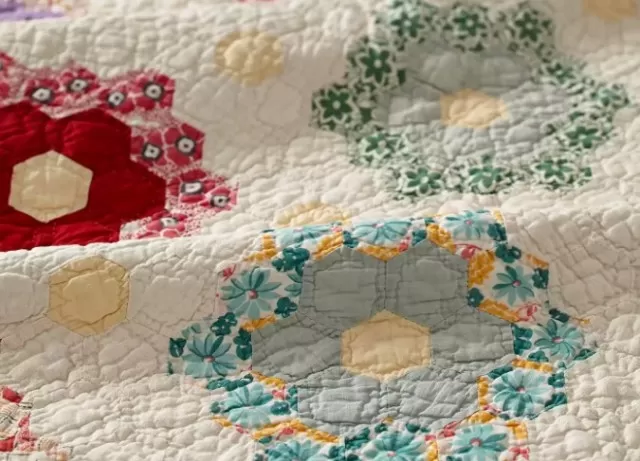Quilts are exquisite bed coverings and widely appreciated forms of textile art. They are commonly adorning beds, and serving as decorative pieces on walls.
It’s important to Wash Quilt periodically, although they require special care compared to regular bedding.
To maintain the vibrant colors and protect the delicate hand-sewn designs and seams, it’s best not to wash quilts frequently.
Ideally, they should be washed two to four times a year. Here are some guidelines on testing a quilt for colorfastness and determining whether to machine Wash Quilt or hand Wash Quilt.
When it comes to washing, machine washing or hand washing depends on the quilt’s fabric, construction, and personal preference.
Machine washing is generally suitable for quilts made of durable materials like cotton or polyester, especially those with simple designs. It’s important to use a gentle cycle with cold water and mild detergent.
To minimize stress on the quilt, it’s advisable to place it in a mesh laundry bag or pillowcase.
Test for Colorfastness when Wash Quilt

To ensure that the colors of a quilt won’t bleed or fade during the Wash Quilt process, it’s crucial to conduct a colorfastness test.
To perform this test, you can dampen a white cloth and gently rub it against a hidden area of the quilt.
If any color transfers onto the cloth or if the colors visibly fade, it indicates that the quilt is not colorfast. In such cases, it is recommended to have the quilt professionally dry-cleaned.
Even if the colorfastness test yields positive results, you may still consider using a dye-catching sheet like Shout Color Catcher or Carbona Color Grabber when washing the quilt as an extra precaution.
These sheets are designed to absorb loose dyes and prevent them from staining other fabrics in the washing machine.
How to Hand Wash Quilt

Washing a quilt by hand is the recommended method, especially for smaller or handmade quilts.
However, keep in mind that washing larger quilts by hand can be labor-intensive due to their bulkiness.
What You Will Need
- Sewing kit (optional)
- Stain treatment product(s)
- Liquid laundry detergent or Engleside Quilt Wash
- Clean towels
Steps to Hand Wash Quilt
Step 1: Check for Repairs and Treat Stains
Before washing the quilt, inspect it for any stains or damage.
Treat stains with a suitable stain remover and mend any holes, rips, or tears. Also, trim any loose threads.
Note that certain stain treatment products, like oxygen bleach, may not be safe for use on silk or wool quilts.
Always refer to the usage instructions to ensure the product won’t harm the quilt.
Step 2: Choose a Washing Area
Select a spacious location that can hold water, detergent, and the quilt while allowing room for your hands to maneuver.
A bathtub or large utility sink is typically suitable.
Step 3: Fill the Basin
Fill the basin halfway with cool water, leaving enough space for the quilt and your hands.
Add 1-2 tablespoons of liquid laundry detergent, depending on the quilt’s size. Avoid using excessive detergent, as it will require extensive rinsing and can leave behind a dull residue on the quilt.
If using Engleside Quilt Wash, mix two scoops per gallon of lukewarm water until fully dissolved.
Step 4: Submerge and Soak the Quilt
Place the quilt in the water and use your hands to fully immerse it.
Gently agitate the quilt to ensure the water and detergent penetrate its fibers, loosening dirt and grime. Allow the quilt to soak in the detergent solution for at least 10 minutes, or longer for heavily stained or soiled areas.
Step 5: Rinse the Quilt
After soaking, lift the quilt out of the detergent solution and gently squeeze it.
Drain the Soapy Water and thoroughly rinse the quilt with Clean Water. Refill the basin, agitate the quilt to release suds, and drain the water.
Repeat this rinsing process until the water runs clear.
Step 6: Dry the Quilt
Once the quilt is thoroughly rinsed, press down on it with your hands while it’s still in the basin to remove excess water.
Avoid wringing the quilt, as it can cause fibers to twist and lead to tearing, fraying, or puckering. Lay the quilt flat on dry towels for air drying (you can place plastic sheeting underneath to protect the floor if needed).
Rotate the quilt every three to five hours to ensure even drying.
How to Machine Wash Quilt

Machine washing is suitable for most commercially made quilts, and handmade quilts can also be machine washed if they are sturdy and colorfast.
Here’s a guide to safely washing a quilt in a washing machine:.
What You Will Need
- Sewing kit (optional)
- Stain treatment product(s)
- Laundry detergent or Engleside Quilt Wash
- Dye-catching sheets (optional)
- Dryer balls
- Clean towels
Steps to Machine Wash Quilt
Step 1: Check for Repairs and Treat Stains
Before washing, inspect the quilt for any stains or damage.
Treat stains with an appropriate stain remover and mend any holes, rips, or tears. Trim loose threads as needed.
Note that certain stain treatment products, like oxygen bleach, may not be safe for use on silk or wool quilts. Always check the usage instructions to ensure the product won’t harm the quilt.
Step 2: Choose Washer Settings
Consult the care tag or manufacturer’s instructions for specific guidelines on machine washing your quilt.
In general, wash quilts in cold water using the delicate cycle, which provides the gentlest wash and spin cycle settings. If using Engleside Quilt Wash, mix two scoops per gallon of lukewarm water and dissolve it completely.
Add this solution to the washing machine as you would with regular liquid laundry detergent. If desired, you can use dye-catching sheets by placing them in the drum along with the quilt.
Step 3: Dry the Quilt
For partial drying in the dryer, use the lowest heat setting and remove the quilt while it is still damp to finish air drying.
To improve airflow and expedite drying, add dryer balls to the dryer, which will help prevent the quilt from clumping. It’s important to note that using a dryer may cause some quilts to shrink or pucker, so exercise caution.
Ideally, it’s best to air dry the quilt flat to maintain its color and shape.
Avoid hanging the quilt, as its weight can strain the seams and cause tearing or uneven distribution of the batting. Instead, lay the quilt flat on clean towels (you can use plastic sheeting underneath to protect the floor, if necessary).
Rotate the quilt every three to five hours to ensure even drying.
By following these steps, you can safely machine wash quilt while preserving its quality and appearance.
*The information is for reference only.